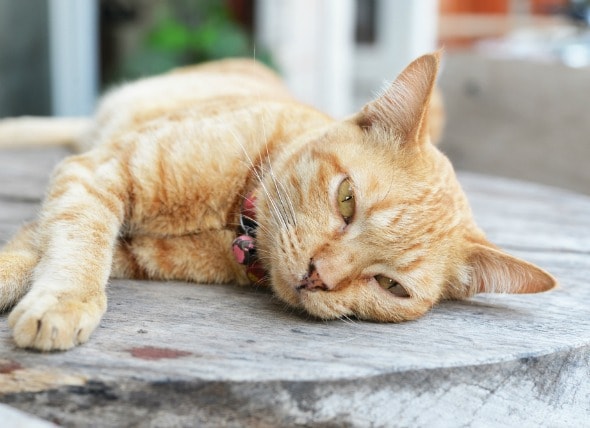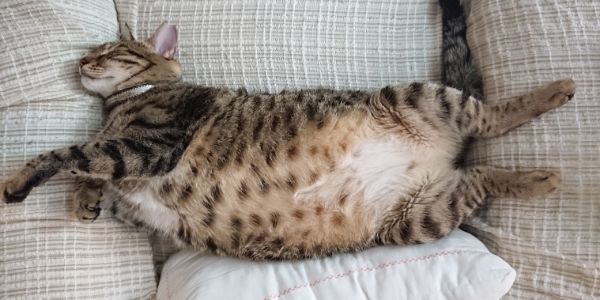
However todays indoor cats are much more likely to become overweight. To prevent fatty liver disease you need to make sure your cat isnt too fat but also that theyre eating an appropriate amount.

To prevent fatty liver disease you need to make sure your cat isnt too fat but also that theyre eating an appropriate amount.
Can cats survive fatty liver disease. Fatty liver disease is the most common form of liver failure in cats. The cat is a carnivorous species ingesting large amounts of protein in the wild. Being overweight was never in the cards for cats that hunted to survive.
However todays indoor cats are much more likely to become overweight. Then if they drastically decrease or stop their food intake those fat stores are mobilized to be converted to energy to keep the cat alive. However the feline liver.
Often known by the laymens term fatty liver this disease occurs when cats especially obese cats go without food for a few days. Untreated hepatic lipidosis can result in liver failure and death so it must be aggressively treated by your veterinarian. Thankfully the prognosis can be excellent with intravenous IV fluids proper nutritional supplementation and supportive care but keep in mind that it can.
Hepatic lipidosis also known as fatty liver syndrome is unique to cats and is one of the most common liver diseases seen in cats. Usually a cat with hepatic lipidosis has recently gone through a period of anorexia. When fat is broken down rapidly to supply energy and nutrients to the anorectic cat it can overwhelm the ability of the liver to process and the fat becomes stored in and around the liver cells further compromising liver function.
Diagnosis of hepatic lipidosis. To prevent fatty liver disease you need to make sure your cat isnt too fat but also that theyre eating an appropriate amount. A decreased or sudden halt in eating is almost always seen in cats with this disease.
You shouldnt think that you can out stubborn your cat by waiting for them to get hungry and start eating again. They will always win this game which actually means that youll both. Without treatment fatty liver disease may rapidly be fatal.
Urgent veterinary assistance is essential. With treatment once the cat has recovered they will often return to normal life without recurrence of this challenging condition. How much does it cost to treat Fatty Liver Disease in cats.
Recovery of Liver Disease in Cats If an affected cat can survive the first few days of treatment the prognosis is generally good for a full recovery between 3-6 weeks. Follow up examinations will be needed to ensure that all organ systems are continuing to heal. Common liver diseases in cats.
Cats can suffer from a wide range of liver diseases which is why a liver biopsy can be so important in determining the underlying cause and finding the most appropriate treatment. Some important conditions include. This is a bacterial infection within the liver causing inflammation.
It is usually a result of bacteria migrating up the bile duct and into the liver from the small intestine. Given the regenerative properties of the liver most diseases are reversible. Recovery rate is usually between 65 and 75 percent if treatment starts at an early stage of the disease.
It usually takes 3 to 6 weeks for a cat to recover from a liver disease but the cat. My cat kismet stopped eating and we never have figured out why but often it is emotional so it it likely from all the change and you being away. In overweight cats it is worse kismet wasnt overweight.
How ever Fatty liver syndrome or hepadic lipidosis is cureable however as I said if your cat is jaundice it wont be easy. Other Health Threats to Worry About If Your Cat Doesnt Eat One long term damage is fatty liver disease or hepatic lipidosis HL. When a cats body does not have enough water or if she does not eat for an extended period of time she may become susceptible to acquiring HL.
This disease if not detected and treated promptly can cause liver failure in cats. Fatty liver disease or feline hepatic lipidosis is a disease characterized by the accumulation of fats or lipids in the liver tissues. It is a common health problem in older and obese cats irrespective of their breed.
It is basically considered an idiopathic condition as no accurate cause has been detected. Recovery of Fatty Liver Disease in Cats. With prompt treatment 80 to 90 percent of cats fully recover from fatty liver disease.
Treatments typically last three to six weeks. The veterinarian will need to monitor the cat during this time with follow-up appointments to ensure that recovery is occurring. On the other hand if a cat has had chronic liver disease that has been untreated their chance of a full recovery is not as likely.
If your cat is diagnosed in the early stages of liver disease there are a few ways to manage their condition in the time they have left. Cats can be switched to a prescription liver approved diet offered daily liver supporting supplements and vitamins and any other support. Fatty liver disease or Hepatic Lipidosis is a disease that occurs when a cats liver is taking in fat more quickly than it can effectively process it.
This results in the build-up of fat in the liver. The extra fat makes it difficult if not impossible for the cats liver to do all of the jobs it is supposed to be doing. This is a very serious and potentially deadly disease.
Overweight and older cats are predisposed to both feline diabetes and Fatty Liver Disease. If liver tests confirm that the cat has feline liver disease the treatment involves appetite stimulants special diets or possibly the insertion of a feeding tube. Cats that have still been eating some food by this point and survive the first four days of treatment are very likely to recover within two.
Fatty liver disease also known as hepatic lipidosis or fatty liver syndrome is a disease that affects a cats liver. It is the most common acquired liver disease in cats and it can be life threatening. 1 In most cases it is the consequence of anorexia and dramatic weight loss in overweight cats.
It is dangerous to put a cat on a crash starvation diet because a starved cat gets energy from her fat supplies which in turn flood the liver with fat. When active liver tissue is swamped with fat the liver can no longer function and goes into liver failure. When fatty liver disease hepatic lipidosis does happen the cat needs intensive care and force-feeding in order to switch off harvesting energy from.